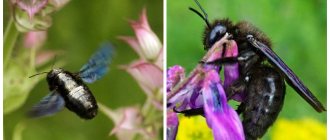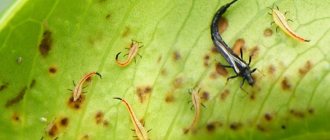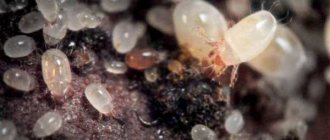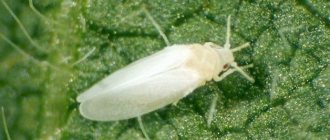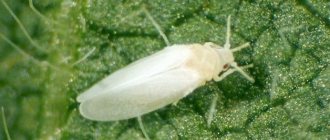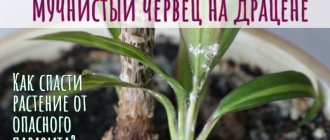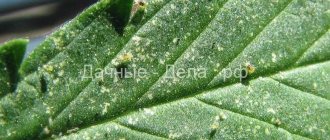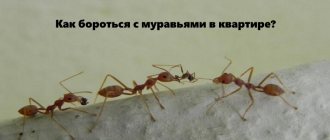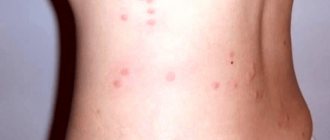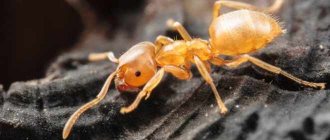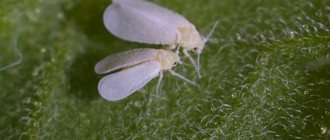Reasons for the appearance of white bugs
Since small insects that are pests of indoor plants reproduce very, very quickly, it is natural to fight them immediately. And the first condition for this is to establish the root cause of their appearance.
White insects, like other insects, show activity in winter and in winter, and experienced gardeners and flower growers call the main reasons for their appearance:
- Excessive waterlogging of the soil in the flowerpot.
- The presence in the soil or flowerpot of components that retain excess moisture.
- Initially, the soil in the flowerpot was contaminated and you planted a new plant in it.
- Fertilizing the soil under flowers with tea leaves or coffee grounds, which are not intended for this at all.
Note! And simply, the penetration of insects into the room through a window or door, or ventilation and, accordingly, subsequent infection of indoor plants.
Preventing plants from mealybug
Mealybug prevention is extremely simple. New flowerpots must be quarantined separately from other indoor flowers for at least a couple of weeks. It is advisable to treat them with antifungal drugs and insecticides at the same time.
It is imperative to keep the flowerpots clean and tidy and remove dry leaves and shoots in a timely manner. And also wash and spray those flowers that need it. After all, flower shops sell special fertilizers in sprays with protective additives.
Photo: landas.ru
Diseases of indoor plants: names, photos and how to deal with them
How to get rid of white bugs on plants?
First of all, you can resort to the help of chemical reagents sold in specialized stores - they act quickly and effectively, and act not only as a means of control, but also as a good preventive measure for the subsequent appearance of midges in flowers.
The products themselves are sprayed near the plant - it is important to remember that they contain insecticides that can harm green spaces if the instructions in strict rules are not followed. In addition, a person should also wear gloves and put on a mask first.
Aktara
The drug does not have any side effects for green spaces, while it is gentle and effective in the fight against insects. But adult, especially tenacious insects can survive and begin to reproduce again.
Inta-vir
The composition does not have a poisonous, suffocating odor and is easily sprayed. But it is worth remembering that in the fight against white insects, the plant should be treated 2-4 times, since one treatment may not be enough to completely destroy the pest.
Fitoverm
The drug has proven itself to be highly effective in controlling pests of indoor plants, but it is worth remembering that it is not suitable for all green spaces. It is also important to strictly follow the instructions due to its toxicity.
Description and appearance
Poduras (or springtails, springtails) are ancient inhabitants of the Earth. These insects have existed for 400 million years. Poduras look like small segmented worms. The body length of adult insects is 0.2-3 mm; there are numerous microscopic bristles on the body.
Soil podurs live in pots with houseplants; they are white or light gray in color. This type of insect does not have wings; it has 3 pairs of legs.
The most interesting organ of these creatures is the furca, or jumping fork, located at the end of the body. At rest, it folds and is fixed on the abdomen. If necessary, the fork can be detached and used for jumping. Such jumps allow insects not to stick to the film of water on the soil surface.
Some researchers believe that jumping is part of the mating “dance” of these insects. It is surprising that with microscopic sizes, springtails can jump to a height of up to 3 cm.
The gnawing type mouthparts are located in the lower part of the head.
They reproduce by eggs, from which hatch larvae that look similar to adults, only smaller in size. After a few molts they reach sexual maturity.
Interesting fact! Until the mid-18th century, springtails were considered worms. Only the naturalist Carl Linnaeus was the first to classify poduras as wingless insects.
Appearance
Folk ways to fight white bugs
If you are wary of store-bought chemicals, you can turn to folk recipes and remedies to combat midges and white insects. Plus, your green plants will not suffer from chemicals even if you overdose the product.
Tops
- At the very beginning, you can use a decoction of tomato tops.
- It is enough to pour 3-4 kilograms of stepsons from a bush with 10 liters of water, boil half an ace and let it brew for a couple of hours.
- Next, the plants are sprayed with it - the main thing is to first dilute the decoction in a ratio of 1 to 3 with water.
- If desired, you can add laundry soap, this will enhance its effectiveness.
- As an option, you can use potato tops - also an effective folk remedy.
- It’s easier to prepare - just pour boiling water over the tops so that the water covers them and let it brew for 8-10 minutes.
- After straining, you treat the plant without diluting it with water; it is even suitable for daily treatment.
Tar soap
- It is used in the form of a soap solution.
- You need to rub a bar of tar soap, dissolve it in a bottle of warm water, shake so that the flakes dissolve and form foam.
- The plant is treated with this foam without washing it off - it forms a protective layer on the green space.
- After some time, you can wash the plant in the shower.
Horsetail
- Its greens, as well as potato tops, are steamed in boiling water, left for 3-5 hours, strain and then the plant itself is sprayed.
- Does not harm the plant, while forming reliable protection around the green space.
- You can not only spray, but also water the soil with this infusion.
Lemon zest
- It is enough to steam 100 dried lemon peels in a liter of boiling water and let it brew in a thermos for 3 days.
- Next, strain the infusion and spray the green plant with it.
- As an addition, you can put fresh peels of any citrus fruit, orange or grapefruit in the flowerpot, changing them periodically.
Garlic
- This aromatic spice is often used by gardeners and flower growers to treat plants against a wide variety of insects and pests.
- You can crush a head of garlic in a mortar, then mix it with water in a ratio of 1 to 1 and leave for a week in the refrigerator.
- Next 25 gr. The infusion is diluted in 10 liters of water, spraying the plants with it.
Pests of indoor plants
The list of pests of indoor flowers is varied. Every culture has its enemies.
White bugs in the soil of indoor plants
Small white bugs that appear in indoor flowers in the ground are a fool. The jumping springtail has an elongated body covered with sparse hairs. Lives in a substrate with humus, feeds on plant remains. It affects the root system, causing the death of the flower.
Diseases and pests
If signs of an insect are detected, you must:
- reduce the frequency of watering;
- create drainage - against mold and souring of the soil mixture;
- add sand to the composition.
Important! Cut potatoes are placed on the surface, and after a few hours they are removed along with the springtails. For chemical processing they use Pochin, Aktara, Bazudin.
White fool
Black bugs on indoor plants
Dark midges on plants are fungus gnats or sciarids. The insects grow up to 7 mm, have an elongated body and black wings (females do not have them). The larvae that feed on the roots of the crop are especially dangerous.
The treatment is carried out with a pinkish solution of potassium permanganate, crushed dill scattered over the surface.
Important! A massive attack of pests is suppressed with Thunder-2, Aktara or Pochin.
Fungus gnat
Aphids are an enemy for plants with soft tissues
It is easy to see: a greenish insect up to 2 mm long, with or without wings.
The sweetish liquid secreted from the pest’s body causes the leaves to stick together and the arrival of ants. Aphid larvae live both on the green part of the plant and in the substrate.
The affected flower is given a shower and geranium is placed nearby - it repels the parasite. In case of severe infection, it is better to use Aktara or Confidor.
Onion root mite
It prefers to feed on onion crops; infected root crops turn into dust. The attack can be determined by the gradually withering plant. Root mites grow in containers without drainage, with abundant watering and constant heat.
The diseased flower must be removed from the rest, the roots inspected and washed with running water. Then place in an insecticidal solution (Neoron or Apollo) for 12 hours, disinfect the pot.
Onion root mite
Spider mite
The mite is small in size - up to 1 mm; its arrival is determined by the sticky web located on the leaves and stem.
It can start if the air is too dry. The leaf blades begin to turn yellow and wither, the plant dies from an attached fungal infection.
To save the culture, it is necessary to begin the fight when the first signs of the disease appear.
Important! Treatment is carried out with Fitoverm or Apollo. Before treatment, you can use a mechanical cleaning method: using a soap solution and a cotton pad.
Common spider mite
Greenhouse whitefly
The greenhouse whitefly resembles a small butterfly or fly, 1.3 to 2.5 mm long. The plant is destroyed not only by adult representatives, but also by their larvae. You can determine the attack by the state of the sheets:
- loss of color;
- twisting;
- yellowness;
- mass decline.
The upper part of the leaf blades is covered with sticky shiny spots. On the reverse side there are larvae, eggs and adults. On the affected foliage, whitish spots initially form, and later dark spots appear. These are signs of sooty fungus joining the main disease. The whitefly carries many phytopathogenic viruses and, when reproducing, can lay up to 300 eggs monthly.
Treatment begins with cutting off the damaged parts and replacing the soil in the container. The plant is taken into a room with low humidity and temperature - up to 10 degrees. Under these conditions, the larvae do not develop, and the adults die. The flower is washed in the shower and treated with Aktara and Confidor.
Greenhouse whitefly
Dangerous thrips
The pests have an elongated body, growing up to 3 mm. Thrips are colored in a variety of shades: from yellowish to black.
It feeds on young leaves, shoots and pollen. On the green part of the affected crop, pinholes and black specks are visible - the result of the vital activity of parasitic thrips.
After a short period of time, similar points are localized throughout the flower, and it begins to fade. The second symptom of infection is gradual discoloration of the leaf blades. If you ignore the signs, the plant faces death.
Thrips prefer to live on flowering crops:
- on indoor roses;
- pelargoniums;
- streptocarpus;
- violets;
- hibicus.
Important! Pests are located not only on the green part of the crop, but also in the soil. You need to treat both the flower itself and the substrate in the container.
The classic treatment for damaged plants is spraying with insecticidal solutions. The procedure can be carried out by Aktara, Fitoverm or Dantop.
To prevent further spread of the pest, the flower is quarantined, all buds are removed - they usually accumulate a lot of thrips. Greens are cleaned mechanically - using a soap solution and a cotton pad. Upon completion of the work, it is covered with a plastic bag and left for 48 hours. After two days, the composition is washed off as carefully as possible - the soap should not get into the soil.
Important! Some gardeners prefer to use a special animal shampoo designed to combat ticks and fleas. It must contain permethrin. Whip up foam in a small volume of liquid and treat the above-ground area of the crop, leave for 30 minutes and rinse off.
Thrips on foliage
Scale insects and false scale insects on indoor plants
Scale insects have a dense chitinous shell, colored in light, cream or dark brown tones. The pest grows up to 4 mm, settles on foliage and shoots, and looks like growths. They are similar to the false scale insect - it does not have protective shells, but causes more damage to plants.
Both parasitic insects feed on the juices of flowers, causing yellowing and wilting of leaf blades and their falling off. A fungal infection penetrates into the microscopic wounds left after bites.
You can get rid of pests using the following procedures: clean the plant with a toothbrush, wash it in the shower with a water temperature of about 50 degrees. Severe infection requires replacing the substrate, treating the green part of the flower with soapy water and chemicals - Golden Spark and Aktara.
Scale insects and false scale insects
Prevention measures
To protect plants from insects and prevent the appearance of white insects in the flowerpot, soil and green mass, you should take into account the following recommendations:
- Water the earthen ball regularly, but without excessive moisture or flooding the plant.
- It is important to ensure that water does not accumulate or stagnate in the pan.
- Buy soil in special stores, plus you should not use organic matter for fertilizing - complex synthetic fertilizers are optimal.
- For watering, use settled, clean water, and after watering and adding, loosen the soil.
- Fallen leaves from the flowerpot should be removed in a timely manner, without creating favorable conditions for the reproduction of midges.
Note! The recommendations are simple, but they always allow you to maintain the beauty of a green and healthy plant.
How do herbs act on bedbugs?
There are a lot of plants that have a repellent effect on blood-sucking parasites, but only a small number of them have a detrimental effect on insects. For example, wild rosemary and tansy have insecticidal properties.
These herbs for bedbugs, which contain toxic substances, destroy adult bedbugs, but do not affect the condition of the eggs.
The remaining plants can be used exclusively for preventive treatment of the premises or as an additional measure during pest control procedures.
Essential oils, which are components of most natural raw materials, will help protect your home for a long time from the invasion of uninvited guests.
Features of the use of insecticides
It is necessary to fight insects on the leaves and larvae in the ground. For this it is better to use special chemicals. Insecticides are potent drugs. Safety precautions must be followed.
Each group has its pros and cons.
Before using any drug, you must carefully study the instructions. Follow the dosage. You should not add more product, otherwise it will lead to the death of the seedlings.
The treatment is carried out in a non-residential area. You can go out onto the balcony or into the courtyard. A man puts on protective clothing, gloves, and a face mask. Animals, children, and other adults are removed from the room.
For treatment, it is better to use several products that are aimed at the soil and the plant itself. First the soil is processed, then the stems and leaves.
Repeated treatment is carried out after a week. The room is washed, ventilated, and hard-to-reach places are cleaned especially well.
Of the cheap and effective insecticides, Dichlorvos is often chosen. It is caustic and can burn plants. For processing you need to take a plastic bag. The product is carefully sprayed inside it. After which the bag is fixed over the seedling. It should not touch the leaves. Therefore, it is secured with a support in the ground or with the help of external objects.
The “greenhouse” is left for 10 hours, after which it is removed. This method effectively gets rid of larvae and adults.
How to choose the right means of control?
In order to choose the right remedy for the treatment of exotics, it is necessary to correctly determine the type of pest and the degree of damage to the orchid . The most dangerous are damage to the rhizome, since by rotting the flower can die.
In addition, the poison that the mealybug injects under the skin of the plant slows down the growth and development of the orchid, which can also lead to its disappearance.
To prevent the appearance of mealybugs, it is necessary to periodically carry out prevention in the form of removing old leaves and flowers, regularly inspecting the flower pot for insects, a warm shower , as well as mandatory quarantine for healthy specimens from the flower garden.
Causes
The main reasons that lead to the appearance of a parasitic worm include:
- Insufficient care of green spaces;
- Average humidity level in the room where the flower is kept;
- Improper watering - too little or too much watering;
- Lack of light.
All these factors create a favorable environment for mold growth. Poor quality soil can also be a source of infection, so when replanting greenery, it is best to use a ready-made soil mixture that has been properly disinfected. There have been cases when powdery mildew was found on newly purchased plants.
To avoid infecting other flowers, it is very important that each new plant is quarantined for several weeks.
It is characterized by a broadly oval body with powdery whitish plates, sometimes with plates along the edges, yellow or pink, and well-developed paws.
Preventive measures
Powdery mildew is quite difficult to control and greatly depletes plants. Therefore, prevention is much more effective.
- The most important preventive measure is to pay attention to how to keep plants healthy, as they usually attack weakened plants.
- Regular inspection of pets will help identify infestations at an early stage.
- Before you bring a new plant into your home, inspect it carefully.
- Quarantine newly acquired pets for at least 30 days.
- Disinfect the soil.
- Disinfect pots thoroughly after sick flowers.
To fight a pest, you need to know its preferences and biological characteristics. Eliminating conditions conducive to parasite development is the primary goal in preventing infestation.
If the pest is identified at an early stage, it is easy to destroy. Simply remove it with a damp cotton swab or brush. Then treat the plant with infusion of tobacco or garlic, or green soap. Then repeat the procedure two more times at an interval of two weeks.
Where to begin
Be sure to isolate the plant on which you notice the pest. Check all the others, especially those that were near the pest.
First, simply clear the plant of pests. Take cotton wool and soak it in alcohol, vodka or soap solution. Carefully remove all insects. Pay special attention to young shoots and leaf axils. Remove those with a lot of bugs. Rinse the plant under a warm shower.
Then treat the flowers with folk remedies or special preparations available in the store.
Before laying eggs, the female penetrates into hard-to-reach places (cracks in the stem, in the axils of leaves, under the folded edges of leaf blades, etc.), builds a cotton cocoon there, lays eggs in it and dies after laying the eggs. The eggs hatch into larvae similar in appearance to females, but smaller in size. Depending on the species, a female flour beetle can lay between 300 and 2,000 eggs. Females and larvae can cause harm.
How to recognize a whitefly infestation
The flour bug leads a secretive lifestyle, hiding in secluded corners of twigs and leaves. If the worms become clearly visible, this means that their numbers have increased so much that all the hiding places are filled.
More often, however, it is not the parasites themselves that are visible, but the traces they leave - sticky drops that look like they have been splashed on the leaves.
To protect your plant from worms, check every twig, look under every leaf, and check the soil. Remove the plant from its pot at the root ball and inspect it. If the roots look like they are covered in ash, it is a worm. However, the same effect can occur with root aphids.
Infected plants will appear as if they are covered with a large amount of cotton wool, and sooty fungus will develop on the pest's sugary secretions.
Powdery mildew: effective methods of controlling and preventing pest infection of plants
The flour bug is a sucking insect that attacks garden and indoor plants, belonging to a large group of beetles belonging to the order Coccidae. These pests are commonly known as “hair lice.” Insects settle on the axes of leaves and buds and suck out plant juices, thereby preventing further development of the plant. If appropriate measures are not taken, the pest will quickly spread throughout the area and lead to the death of plants.
It is a contact and enteric insecticide that was originally developed for garden plants. However, it also shows excellent effectiveness against powdery mildew. The active ingredient in the drug is quite dangerous, so dosage and precautions must be carefully observed.
What does a flour beetle look like?
alt=”flour beetle” width=”460″ height=”345″ />
Flesh eaters (otherwise known as false huggers and butterflies) are insects of the Hemiptera family, which has more than 2,200 species. There are far fewer species in Europe, only 330, but even this is enough to cause significant damage to plants.
Female and male flour bugs are very different from each other. The male has wings and looks like a small fly or mosquito. Female plants look different, with an oval body (3-6, and sometimes up to 10 mm in length), covered with a white, powdery or waxy coating. There are waxy plates along the edges or on the back. Some species have several pairs of limbs necessary for movement, while others leading a sedentary lifestyle do not have them. Females have mouthparts for sucking. Males are completely deprived of this organ: they are not able to take food, so they do not cause any harm to plants.
alt=”powdery mildew” width=”460″ height=”307″ />
Before laying eggs, the female moves to a hard-to-reach place (cracks in the trunk, in the axils of leaves, under the folded edges of the leaf blade, etc.), builds a cotton cocoon there, lays eggs in it and dies after laying the eggs. The eggs hatch into larvae similar in appearance to females, but smaller in size. Depending on the species, a female flour beetle can lay between 300 and 2,000 eggs. Female and larval worms can cause harm.
Treatment should be carried out as a combination of several methods. Chemical treatment is usually effective in combination with mechanical removal.
